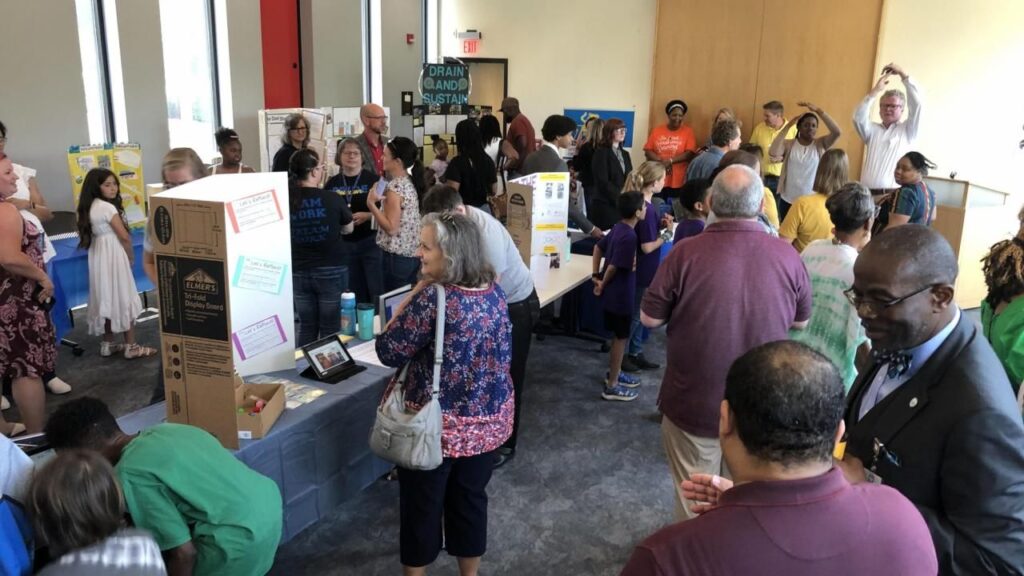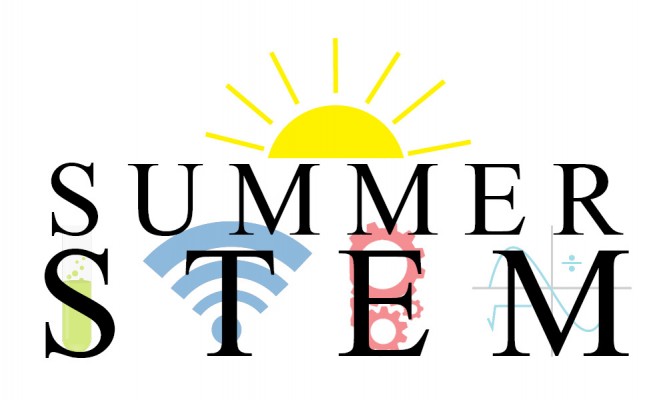Thousands of Wake County Public School System students this year worked with their classmates on a year-long, hands-on project — work that Superintendent Robert Taylor said is important for learning and career readiness.
First-grader Kezia Montague has been telling her parents for weeks about one of her biggest contributions to science so far: A class project on improving the drainage and environmental sustainability at her school’s courtyard. She and a fellow student would be presenting their work and findings to a roomful of adults Wednesday.
“It builds the confidence of the child,” her father, Travis Montague, said of the project. “That’s what I like about it.”
Kezia was one of thousands of Wake County Public School System students this year who worked with their classmates on a year-long, hands-on project facilitated by WakeEd Partnership’s SummerSTEM, which presented some of the year’s worth of projects during Wednesday’s annual STEMposium in downtown Raleigh.
WakeEd Partnership is a nonprofit that works with the business community to facilitate programming for the Wake County Public School System. SummerSTEM, which partners with local companies and tries to expose children to different career paths, is just one program that brings project-based learning into Wake County’s K-12 classrooms.
Project-based learning is a style of learning that teaches students essential academic standards while they apply that knowledge to an intensive and extensive project, devising and creating something. It’s intended, in part, to make learning more engaging.
Research shows better academic outcomes for students who participate in project-based learning, although experts note that project-based learning can be implemented in different ways that may yield different outcomes. Some of the challenges to making it work include choosing the right projects and making sure no students are left out during the work.
At the STEMposium, students and teachers presented projects on growing plants, making scented body scrubs, improving the drainage at their school garden, and building an app that tracks and supports addiction recovery, among many other projects.
On Wednesday morning, Kezia was ready for her big day.
“The problem is, [the courtyard] is not draining well,” she explained to WRAL News. So her class toured the courtyard at Zebulon Magnet Elementary School. They learned about different soil types. They asked questions about what they thought about the courtyard and what they wanted the courtyard to be like.
“We asked, ‘How can we improve the drainage in our courtyard and transform it into a usable space?’” Kezia said. Asking those big questions was Kezia’s favorite part.
The class made plans to use gravel, make a learning space and make a rain garden. They’ll make the courtyard higher on the sides and shorter in the middle, and they’ll put extra drains in. The rain garden will collect water.
Kezia’s classmate Glenna Elliott said her favorite part was the “imagining” process. “Because you can imagine what you wanted it to look like and make it into 3D and make your bigger imagination come true and now it’s actually in place.”
Project-based learning is a way of teaching students about the value of what they’re learning directly; when they use what they’ve learned in hands-on projects, they can see what they’re learning in action and know exactly why what they’re learning is practical, said Douglas Price, WakeEd Partnership’s director of programs.
Students might wonder, “‘Why is it that we have to learn that x plus y equals z? And how does that relate to me in the real world?’” Price said. “These projects are giving that real world capacity and that real world component to the students to help them…. and understand, ‘OK this does have applicability to me and maybe what I want to do someday. Or not do someday.’”
This type of learning is growing in popularity, but it’s not necessarily easy to execute — at least, on this scale — without support.
Price said teachers might struggle to form their own projects amid the everyday requirements and regulations of the classroom. The WakeEd program sets teachers up to do this during the summer instead, by connecting them with companies that want to help bring science to life in classrooms. Teachers take professional development and work with company representatives on ideas for projects and what would be needed to do them. Then, when the school year starts, teachers have a plan to engage their entire classroom in a year-long project that starts with asking questions and ends with a final product.
John Deere, BASF, Gensler and Wolfspeed arming the companies that participate.
Wake County Public School System teachers can still apply for this summer’s program, which also includes continuing education credits and a stipend. While the program is popular among magnet school teachers, any teachers can apply. The program is capped at 100 teachers — a cap leaders used to hit but haven’t the past couple of years. Keith Poston, WakeEd Partnership’s executive director, said he thinks burnout is playing a role, based on what he’s heard from teachers.
But Price said many teachers — in addition to students — find the project learning fulfilling and more creative.
“It is refreshing to see their enjoyment and their just excitement for wanting to learn and get involved,” said Maria Wilkins, a second grade teacher at Millbrook Environmental Connections Magnet Elementary School, whose students are learning about how to grow and use plants.
“They come happy and ready. They get dirty, they get messy and have a great time. They learn. They can talk about what they’ve learned with others.”
Josephine Kearse, a third-grader at Millbrook, thinks she wants to be a botanist when she grows up. She enthusiastically explains all of the things the school grows and makes. They grow vegetables for families at the school to take home. They make a variety of scented body scrubs.
 Teachers and a student from Millbrook Environmental Connections Magnet Elementary Schools explain their projects growing plants and making products with them, including scented body scrubs, to visitors during the WakeEd Partnership’s STEMposium event on May 8, 2024. The even showcases classroom projects intended to make learning more engaging and expose children to careers. WRAL/Emily Walkenhorst
Teachers and a student from Millbrook Environmental Connections Magnet Elementary Schools explain their projects growing plants and making products with them, including scented body scrubs, to visitors during the WakeEd Partnership’s STEMposium event on May 8, 2024. The even showcases classroom projects intended to make learning more engaging and expose children to careers. WRAL/Emily Walkenhorst
“What I love most about this project is that we get to go outside and just grow things and then we get to hand out things, and it makes me feel really good,” Josephine said. She’s learning a lot.
Project-based learning is an enhancement for the students and herself, Wilkins said.
Without it, she said, learning “wouldn’t be as fun, wouldn’t be as meaningful. The impact wouldn’t be the same.”
This is the type of learning — and exposure to career paths — is important for students, Wake County Public School System Superintendent Robert Taylor told the crowd at the STEMposium.
He talked about visiting Kezia and Glenna’s booth, Drain and Sustain.
“I was able to see the gleam in their eyes and the idea of what their future could be like based on what they’re learning in classrooms and what we do,” Taylor said. “So, this is absolutely what we want to be able to see.”
Wake County Public Schools Teachers Apply Here for SummerSTEM


